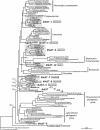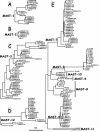Phylogenetic and ecological analysis of novel marine stramenopiles
- PMID: 15184153
- PMCID: PMC427732
- DOI: 10.1128/AEM.70.6.3528-3534.2004
Phylogenetic and ecological analysis of novel marine stramenopiles
Abstract
Culture-independent molecular analyses of open-sea microorganisms have revealed the existence and apparent abundance of novel eukaryotic lineages, opening new avenues for phylogenetic, evolutionary, and ecological research. Novel marine stramenopiles, identified by 18S ribosomal DNA sequences within the basal part of the stramenopile radiation but unrelated to any previously known group, constituted one of the most important novel lineages in these open-sea samples. Here we carry out a comparative analysis of novel stramenopiles, including new sequences from coastal genetic libraries presented here and sequences from recent reports from the open ocean and marine anoxic sites. Novel stramenopiles were found in all major habitats, generally accounting for a significant proportion of clones in genetic libraries. Phylogenetic analyses indicated the existence of 12 independent clusters. Some of these were restricted to anoxic or deep-sea environments, but the majority were typical components of coastal and open-sea waters. We specifically identified four clusters that were well represented in most marine surface waters (together they accounted for 74% of the novel stramenopile clones) and are the obvious targets for future research. Many sequences were retrieved from geographically distant regions, indicating that some organisms were cosmopolitan. Our study expands our knowledge on the phylogenetic diversity and distribution of novel marine stramenopiles and confirms that they are fundamental members of the marine eukaryotic picoplankton.
Figures


References
-
- Arndt, H., D. Dietrich, B. Auer, E. J. Cleven, T. Gräfenhan, M. Weitere, and A. P. Mylnikov. 2000. Functional diversity of heterotrophic flagellates in aquatic ecosystems, p. 240-268. In B. S. C. Leadbeater and J. C. Green (ed.), The flagellates: unity, diversity and evolution. Taylor & Francis Press, London, United Kingdom.
-
- Baldauf, S. L. 2003. The deep roots of eukaryotes. Science 300:1703-1706. - PubMed
-
- Bhattacharya, D., and L. Medlin. 1995. The phylogeny of plastids: a review based on comparisons of small-subunit ribosomal RNA coding regions. J. Phycol. 31:489-498.
-
- Caron, D. A., E. R. Peele, E. L. Lim, and M. R. Dennett. 1999. Picoplankton and nanoplankton and their trophic coupling in the surface waters of the Sargasso Sea south of Bermuda. Limnol. Oceanogr. 44:259-272.
Publication types
MeSH terms
Substances
Associated data
- Actions
- Actions
- Actions
- Actions
- Actions
- Actions
- Actions
- Actions
- Actions
- Actions
- Actions
- Actions
- Actions
- Actions
- Actions
- Actions
- Actions
- Actions
- Actions
- Actions
- Actions
- Actions
- Actions
- Actions
- Actions
- Actions
- Actions
- Actions
- Actions
- Actions
- Actions
- Actions
- Actions
- Actions
- Actions
- Actions
- Actions
- Actions
- Actions
- Actions
- Actions
- Actions
- Actions
- Actions
- Actions
- Actions
- Actions
- Actions
- Actions
- Actions
- Actions
- Actions
- Actions
- Actions
- Actions
- Actions
- Actions
- Actions
- Actions
- Actions
- Actions
- Actions
- Actions
- Actions
LinkOut - more resources
Full Text Sources
Other Literature Sources
Molecular Biology Databases

